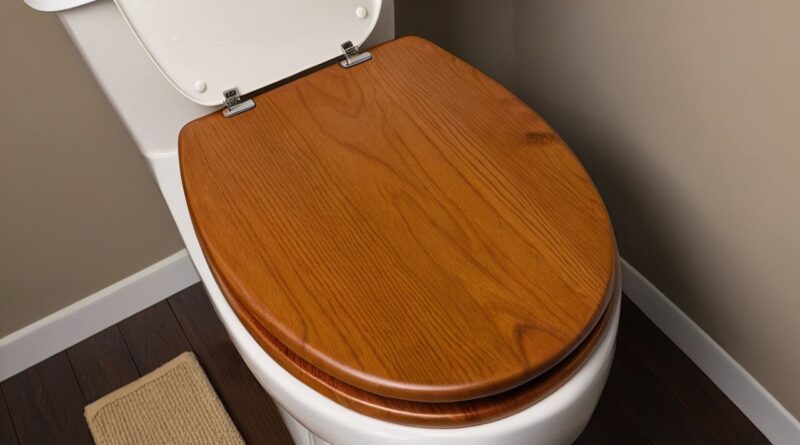How to Clean a Wood Toilet Seat: A Simple Guide to Keep It Spotless
When it comes to maintaining a clean and inviting bathroom, the toilet seat often takes center stage. Wooden toilet seats, in particular, add a touch of warmth and elegance to any space, but they require a little extra care to keep them looking their best. Unlike plastic alternatives, wood is more sensitive to moisture and harsh chemicals, which can damage its finish and shorten its lifespan. So, how can you strike the perfect balance between hygiene and preservation?
In this post, we’ll explore the best techniques for cleaning a wood toilet seat effectively and safely. You’ll learn about the importance of choosing the right cleaning products, how to tackle stubborn stains without harming the wood, and tips for maintaining the seat’s finish over time. Whether you’re dealing with a quick wipe-down or a deeper cleaning challenge, these expert tips will ensure your wooden toilet seat remains both sanitary and beautiful for years to come. Ready to transform this often-overlooked bathroom feature into a shining example of cleanliness? Let’s dive in!
Step-by-Step Guide to Clean a Wood Toilet Seat
Keeping your wooden toilet seat clean is essential for hygiene and maintaining its appearance. Follow these simple steps to clean it safely and effectively:
1. Gather Your Supplies
You’ll need the following:
- A mild dish soap or gentle wood cleaner
- Warm water
- A soft cloth or sponge
- White vinegar (optional for deeper cleaning)
- Baking soda (optional for stubborn stains)
- A microfiber towel for drying
2. Prepare the Cleaning Solution
Mix a few drops of mild dish soap with warm water in a small bowl or bucket. Avoid harsh cleaners or abrasive chemicals, as they can damage the wood’s finish.
3. Wipe Down the Surface
Dip the soft cloth or sponge into the soapy water and wring it out well. Gently wipe the wooden toilet seat, ensuring you clean both the top and underside. Focus on areas where dirt or stains are visible.
4. Address Stubborn Stains (Optional)
For tougher stains, create a paste using baking soda and water. Apply the paste to the stained area and let it sit for 5–10 minutes. Gently scrub with a soft sponge or cloth, then rinse with warm water.
5. Sanitize with Vinegar (Optional)
If you want to sanitize the seat, mix equal parts white vinegar and water. Lightly spray the solution onto the seat, let it sit for a few minutes, then wipe it off with a damp cloth. Avoid letting vinegar sit for too long, as it can dull the wood finish.
6. Dry Thoroughly
Use a clean microfiber towel to dry the seat completely. This step is crucial, as wood is sensitive to moisture, which can cause warping or cracking over time.
7. Apply a Protective Finish (Optional)
If your wooden seat looks dull or worn, consider applying a wood-safe polish or wax to restore its shine and provide an extra layer of protection.
By following these steps, you can keep your wooden toilet seat clean, hygienic, and in excellent condition. Regular maintenance will not only preserve its beauty but also extend its life, ensuring it remains a stylish and functional part of your bathroom.
Table of Equipment for Cleaning a Wooden Toilet Seat
Here’s a detailed table outlining the equipment needed, its purpose, pros, cons, and best practices for cleaning a wooden toilet seat effectively.
| Equipment | Purpose | Pros | Cons | Best Practices |
|---|---|---|---|---|
| Soft Sponge | Applying cleaning solutions | Gentle, flexible, non-scratch | Can harbor bacteria if not sanitized regularly | Use a clean sponge; replace frequently. |
| Microfiber Cloth | Wiping and drying surfaces | Highly absorbent, reusable, lint-free | Requires washing to maintain effectiveness | Have separate cloths for cleaning and drying. |
| Toothbrush (Soft-Bristle) | Cleaning tight or intricate areas (e.g., hinges) | Precise cleaning, easy to control | Small size makes it less efficient for larger areas | Use only for cleaning; sanitize after use. |
| Bucket or Bowl | Mixing cleaning solutions | Keeps cleaning solutions contained | None | Use a size appropriate for the cleaning solution. |
| Spray Bottle | Spraying cleaning solutions evenly | Easy to apply diluted vinegar or water solutions | Not ideal for heavy application of solution | Label bottles clearly to avoid confusion. |
| Towel or Rag | Drying the wood after cleaning | Readily available, absorbent | Less durable than microfiber cloths | Ensure it’s dry and clean before use. |
| Rubber Gloves | Protecting hands from cleaning solutions | Shields skin from irritation, improves grip | May feel uncomfortable over long use | Choose well-fitting, reusable gloves. |
| Wood-Safe Polish Applicator | Applying wood polish or wax | Designed for even application | May require cleaning after use | Use only with polish; wash applicator when done. |
Key Tips for Using the Equipment:
- Prioritize Soft Materials: Use non-abrasive tools like microfiber cloths and soft sponges to prevent scratches on the wood surface.
- Sanitize After Use: Clean tools like sponges, toothbrushes, and cloths after each session to prevent bacteria buildup.
- Designate Tools: Keep specific tools for bathroom cleaning to avoid cross-contamination with other areas of your home.
- Store Properly: Dry and store all equipment in a clean, ventilated area to maintain hygiene and prolong their lifespan.
This equipment list, paired with proper care, will make the cleaning process efficient and ensure your wooden toilet seat remains in excellent condition.
Why Should You Clean a Wood Toilet Seat?
Cleaning a wood toilet seat is essential for several reasons, ranging from hygiene to durability. Unlike other materials, wood requires special care, and neglecting its upkeep can lead to both aesthetic and functional issues. Here’s why you should prioritize cleaning your wooden toilet seat:
- Hygiene and Sanitation
Toilet seats, regardless of material, are high-contact surfaces that accumulate bacteria, germs, and grime. Regular cleaning ensures a sanitary environment, preventing the spread of harmful microorganisms and maintaining a healthy home. Wood, with its porous nature, can be particularly vulnerable to absorbing bacteria and odors if not cleaned properly. - Preservation of Appearance
Wooden toilet seats add warmth and elegance to a bathroom, but dirt, stains, and moisture can dull their finish over time. Cleaning them regularly helps preserve their natural beauty and prevents discoloration or surface damage, keeping your bathroom looking pristine. - Extending Lifespan
Moisture and harsh cleaning products can weaken wood, causing it to crack, warp, or lose its protective finish. Proper cleaning with gentle methods not only keeps the seat hygienic but also protects the material, extending its lifespan and saving you from costly replacements.
By incorporating regular cleaning into your routine, you can enjoy a beautiful, durable, and hygienic wooden toilet seat that complements your bathroom’s style while promoting a healthy environment.
When it comes to cleaning a wooden toilet seat, the key is balancing thorough cleaning with protecting the wood’s natural beauty and finish. Having tried various products and methods, I’ve found that simple, non-abrasive solutions work best—not just for cleaning but also for extending the life of the seat. Here’s my detailed take on what works and why.
First, let’s talk about the cleaning solution. I swear by a mixture of mild dish soap and warm water. It’s effective at breaking down everyday grime without being too harsh. A gentle dish soap, especially one with a plant-based formula, feels safer for wood, and I appreciate how well it cleans without stripping the finish. White vinegar is another favorite of mine, particularly for its natural disinfectant properties. I dilute it with water to reduce its acidity, which could otherwise damage the wood. It’s perfect for occasional deeper cleaning, though I wouldn’t recommend it for regular use.
For cleaning tools, a soft sponge or microfiber cloth is essential. Sponges are great for evenly spreading the solution, and the microfiber cloths are my go-to for wiping and drying because they don’t scratch the wood. I also like to keep a toothbrush on hand for cleaning hard-to-reach areas like the hinges—it’s an underrated tool that does wonders for detailed cleaning.
When tackling stains, a baking soda paste is surprisingly effective. It’s gentle on wood but tough on discoloration. I’ve had excellent results removing water spots or light stains without scrubbing too hard. The trick is patience—let the paste sit for a few minutes before gently wiping it away.
Finally, drying is critical. Moisture is the enemy of wood, so I always take the time to dry the seat thoroughly with a fresh microfiber towel. As a finishing touch, I sometimes apply a wood-safe polish or beeswax. This not only restores the seat’s natural luster but also adds a protective barrier against moisture.
The process is straightforward and satisfying. Each step feels like giving the wood a little TLC, and the results speak for themselves—a clean, polished toilet seat that looks as good as new. Plus, knowing I’m using safe, effective methods is an added bonus. With the right materials and approach, cleaning a wood toilet seat can be more than a chore—it’s a quick way to make your bathroom shine!
Here’s an in-depth look at the key ingredients and materials commonly used to clean a wooden toilet seat, along with a comparison table for easy reference
1. Mild Dish Soap
Properties: A gentle, versatile cleaner that cuts through dirt, oils, and grime without damaging the wood finish.
Advantages: Safe for regular use, readily available, and affordable.
Disadvantages: Not effective for deep stains or heavy sanitization.
2. White Vinegar
Properties: A natural disinfectant and deodorizer, vinegar can break down buildup and sanitize surfaces.
Advantages: Non-toxic, eco-friendly, and great for occasional deep cleaning.
Disadvantages: Acidity may damage wood finish over time if used too often or undiluted.
3. Baking Soda
Properties: A mild abrasive cleaner that helps remove tough stains without scratching.
Advantages: Gentle yet effective for stain removal, safe for wood when used sparingly.
Disadvantages: Can leave residue if not rinsed thoroughly.
4. Microfiber Cloths
Properties: Soft, non-abrasive cloths that effectively clean and dry surfaces without scratching.
Advantages: Reusable, lint-free, and highly absorbent.
Disadvantages: None, though they require regular washing to maintain effectiveness.
5. Beeswax or Wood-Safe Polish
Properties: A protective coating that nourishes wood and restores shine.
Advantages: Adds moisture resistance and enhances appearance.
Disadvantages: Requires periodic application and may not suit all wood finishes.
6. Soft Sponges
Properties: Gentle cleaning tools ideal for spreading solutions without damaging wood.
Advantages: Flexible, non-scratch, and effective for everyday cleaning.
Disadvantages: Can harbor bacteria if not sanitized regularly.
Comparison Table: Cleaning Ingredients for Wooden Toilet Seats
| Ingredient/Material | Purpose | Pros | Cons | Frequency of Use |
|---|---|---|---|---|
| Mild Dish Soap | General cleaning | Safe, effective, and affordable | Limited stain and sanitization power | Regular |
| White Vinegar | Disinfecting and deodorizing | Eco-friendly, natural, and powerful for sanitization | Can damage wood finish if overused | Occasional (monthly) |
| Baking Soda | Stain removal | Gentle on wood, effective for tough stains | Leaves residue if not rinsed thoroughly | As needed (spot cleaning) |
| Microfiber Cloths | Cleaning and drying | Non-scratch, reusable, lint-free | Needs washing to stay effective | Always |
| Beeswax/Wood Polish | Protection and shine | Enhances durability, restores finish | Requires regular reapplication | Every 2–3 months |
| Soft Sponges | Applying cleaning solution | Flexible and safe for wood | Can trap bacteria if not cleaned | Regular |
This detailed breakdown and comparison table should help you choose the right ingredients and materials for maintaining your wooden toilet seat, based on the level of care and cleaning it requires.
F.A.Q. Section: Cleaning a Wooden Toilet Seat
Q: How often should I clean my wooden toilet seat?
A: Ideally, you should clean your wooden toilet seat at least once a week to maintain hygiene. For deeper cleaning or sanitizing, aim for once a month or as needed if there are visible stains or odors.
Q: Can I use bleach or harsh chemicals to clean a wooden toilet seat?
A: No, bleach and harsh chemicals can damage the finish of a wooden toilet seat and weaken the wood over time. Stick to mild dish soap, diluted vinegar, or wood-safe cleaners.
Q: What is the best way to sanitize a wooden toilet seat?
A: Mix equal parts of white vinegar and water, spray it lightly on the seat, let it sit for a few minutes, and then wipe it off with a damp cloth. Always dry thoroughly afterward to prevent moisture damage.
Q: How can I remove tough stains from a wooden toilet seat?
A: For tough stains, create a paste using baking soda and water. Apply the paste to the stain, let it sit for 5–10 minutes, and gently scrub with a soft sponge. Rinse and dry thoroughly.
Q: Can I use furniture polish on a wooden toilet seat?
A: Yes, wood-safe polish or beeswax can be used to protect the finish and restore shine. Ensure the product is non-toxic and suitable for wood that comes into contact with skin.
Q: What should I avoid when cleaning a wooden toilet seat?
A: Avoid abrasive tools like steel wool, harsh chemicals, excessive water, or soaking the wood. These can scratch, dull, or warp the seat.
Q: How do I clean the hinges of a wooden toilet seat?
A: Use a soft-bristled toothbrush dipped in mild soapy water or vinegar solution to gently scrub the hinges. Wipe away residue with a damp cloth and dry the area thoroughly.
Q: Why does my wooden toilet seat smell even after cleaning?
A: Persistent odors may indicate that moisture or bacteria have penetrated the wood. Try using a vinegar solution for deeper sanitization, and ensure the seat is completely dry after each cleaning. Applying a protective polish may help prevent future issues.
Q: Can I repaint or refinish my wooden toilet seat?
A: Yes, if the seat’s finish is worn or damaged, you can sand it lightly and apply a new wood-safe paint or finish. Ensure the product is moisture-resistant and suitable for frequent cleaning.
Q: Is it worth maintaining an old wooden toilet seat?
A: If the wood is structurally sound and free from significant damage, regular cleaning and maintenance can restore its appearance and functionality. However, if the wood is cracked or warped, consider replacing it for hygiene and comfort.
This F.A.Q. covers common concerns and ensures your wooden toilet seat remains clean, beautiful, and durable!




